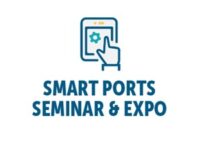Smart Shipping Revolution Underway
Value of Data Collection, Integration, Collaboration Becomes Clear as Ports Explore Seamless Cargo Transport Services and the Role of Industry 4.0.

By Barry Parker
A smart shipping revolution encompassing 2020 to 2050 is already underway and seamless cargo transport services between all parts of the world, integrated with suppliers and receivers, will be the landscape of our future maritime shipping world, according to Dr. Martin Stopford.
Stopford, the president of Clarksons Research Services (tied to the international maritime intermediary Clarksons Platou), shared these thoughts in a whitepaper he presented in 2020 and in his book, Maritime Economics. The Oxford graduate envisions radical adjustments for shipping as it embraces the accelerating Industry 4.0 digital revolution and believes that the COVID-19 pandemic could prove to be just the catalyst the industry needs.
Stopford noted how the events of the past year have underscored the need for data integration – including on the regulatory side. “The pandemic has taught us that fighting global threats calls for cooperation and leadership. Shipping faces problems in both of these areas because it is fragmented…Ports and terminals are the link between these ships and commercial trading networks, putting them in line for a new ‘hot job.’ Who better to coordinate and quietly take the lead in developing the commercial policies and protocols needed to monitor ship emissions, coordinate logistics data and integrate cargo documentation.”
The world’s seaports are a critical node in the seamless transport vision, and AAPA has taken a leadership role in bringing together the right groups of experts as ports in the Americas roll out digital technologies. This commitment was evident at AAPA’s January 2020 Smart Ports event held in Los Angeles. Speakers Bart Vermeer and Ashebir Jacob, from Moffat & Nichol, presented an overview of technical aspects of connectivity within a port. In slides detailing the digital view for stakeholders in a port, they explained that multiple devices on multiple networks can bring about “multi-sector secured and efficient collaboration.” Their definition of collaboration comes down to “cross-sector connections between port, terminal, rail, truck etc. for optimum decision-making.” These days, communications are increasingly automatic, systems managing information regarding cargoes talk to each other – typically via application programming interfaces (APIs), rather than by users entering information after manually logging in.
In the Port of Los Angeles, the Port Optimizer, developed in conjunction with General Electric and then Wabtec Corporation (a provider of information solutions for all the transport modes) is essentially “a system of systems that ties together all the disparate data going through the port,” according to Chris Chase, marketing manager at the port. He added that “it’s a neutral portal, an umbrella, for all the information flowing through, put together in an easy functional way so folks can make better decisions.” He explained that users can interface it through the “Control Tower” data tool, which he described as a way to show aggregated or high level data, or specific data.”
Eastward across San Pedro Bay, at the Port of Long Beach (POLB), an online dashboard that debuted in late 2020 is enhancing visibility for supply chain participants, who have seen unprecedented cargo inflows with restocking. Lee Peterson, from POLB, explained that the WAVE (Weekly Advance Volume Estimate) report was started in December 2020 “to provide our goods movement stakeholders with up-to-date, forward-looking data to use in their planning process. The report was initiated to help the port and its stakeholders cope with an unprecedented volume of cargo that began in July 2020, and still continues in April 2021.”


